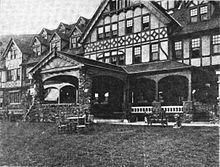The village is home to neighborhoods, business and residential areas, including the central business district, the hamlets of Scarborough and Chilmark and residential areas Central Briarcliff West, the Tree Streets and the Crossroads. Scarborough, often called Scarborough-on-Hudson because it borders the Hudson River, is a .45-square-mile (1.2 km2) unincorporated district divided between Briarcliff Manor and the village of Ossining, with most of the area within Briarcliff Manor and a few streets in the village of Ossining. Scarborough is largely residential, and has some of the most expensive houses in the village, due in part to its proximity to the Hudson. Condominium complexes within Scarborough include Kemeys Cove, built in 1974, and Scarborough Manor, a 7-story, 205-unit complex built in the 1960s.[34] The hamlet has a post office and a station on the Metro-North Hudson Line within walking distance of most houses in the hamlet.[34] Unlike most of Briarcliff Manor, Scarborough is within the Ossining Union Free School District. During the 17th century, Scarborough became one of the first trading posts for the Dutch on the Hudson. During the early 20th century, the Astor, Rockefeller and Vanderbilt families entertained guests on their river-view country estates in the Scarborough area. The Scarborough Historic District, including the Scarborough Presbyterian Church, is on the National Register of Historic Places. Across the street from the church is Sparta Cemetery, with the graves of local Revolutionary War veterans and the Leatherman. Scarborough was incorporated into Briarcliff Manor in 1906.[5](p44) A notable building is Beechwood, built around 1780 and considered one of the finest examples of Federal architecture in Westchester County.[14] William Creighton, founder of St. Mary's Episcopal Church, named the house "Beechwood" after he purchased it in 1836.[4](p8) Beechwood was later purchased by Frank A. Vanderlip, who constructed the Scarborough School on the estate. The school was founded in 1913,[35] and closed in 1978. Holly Hill is also part of the historic district. Hubert Rogers, a New York City attorney, had the house designed around 1927 by William Adams Delano; Rogers named it Weskora. After his death Brooke Astor purchased the estate, renaming it Holly Hill for its holly trees.[5](pp116–7) Directly across from Holly Hill is the U.S. headquarters of Philips Research, built on part of Waldheim, the former 130-acre (53 ha) estate of James Speyer.[36]
Chilmark (also known as Chilmark Park) is an unincorporated residential community of about 300 acres (120 ha), established in 1925, in northern Briarcliff Manor. The neighborhood was designed with Underhill Road as its main thoroughfare, running north-south.[37] It was named after the village of Chilmark, England, located near the home of Thomas Macy (an ancestor of Valentine Everit Macy), who arrived in the colonies in 1635. The area is culturally significant for its association with the Macy family, whose members were active in New York and Westchester County during the 19th and early 20th centuries. Valentine Everit Macy and his wife, Edith Carpenter Macy, founded the community and aided in its development; Macy purchased several small family farms in present Chilmark in 1897.[37] In 1925, Macy donated 265 acres (107 ha) on Old Chappaqua Road for the first national Girl Scout camp, which later became the Edith Macy Conference Center, a conference and training facility owned and operated by the Girl Scouts of the USA.[17] The Briarcliff Recreation Center was formerly the private Chilmark Club until the 1970s, when the village purchased the land for a recreation center and adjoining park. Macy's residence in the area was the Chilmark estate, a Tudor-style stone and stucco mansion built in 1896 with a nine-hole golf course. The neighborhood hosts Briarcliff Manor's Conservative temple Congregation Sons of Israel.[14]
Chilmark features landscaped, winding roads designed to blend with the topography, access to transportation (including a commuter rail line and a highway and homes built in revival styles echoing Tudor and Gothic architecture; it is architecturally significant as an example of early-20th-century suburban design.[37] During the 1920s Macy's son, V.E. Macy Jr., founded the Chilmark Park Realty Corporation to sell land parcels. When he began marketing the area, he renovated or demolished existing homes to lend an air of development and built a private 8.3-acre (3.4 ha) country club for use by Chilmark residents. The village of Briarcliff Manor later purchased the site, and operates it as Chilmark Park. To denote its development as an exclusive neighborhood, Macy planted distinctive shade trees along Underhill Road. Since its founding, additional homes have been built in Chilmark, most between 1955 and 1960.[5](p146) The developments expanded the area beyond its original 300 acres; it presently comprises Underhill Road and the streets immediately adjacent to it.[37]
The central business district, also known as the Village Center, is located on Briarcliff Manor's main street on Pleasantville Road and continues on North State Road.[38] The area has numerous businesses lining Pleasantville Road, a large expansion from the three stores that existed there in 1906.[5](p67) The business district is home to the village hall and a pocket park, and has brick sidewalks, period street lighting, and free parking.[28][39] Farther south along the road is the Walter W. Law Memorial Park, and further east along the road are the three schools of the Briarcliff Manor Union Free School District. The Village Center contains a number of pre-Revolutionary War houses, including the Whitson House, built during the 1770s and the former home of Richard Whitson (one of the Whitson brothers, after whom Whitson's Corners was named); Buckhout House, also dating to the 1770s and named for the family who lived there for over a century and the oldest, Century Homestead, dating to about 1767 and first owned by Reuben Whitson.[14] The Washburn House, another pre-Revolutionary house, was sold by the New York State Commission on Forfeiture to Joseph Washburn in 1775.[4](p7)
Central Briarcliff West is a neighborhood which has a number of mansions built by 20th-century millionaires who stayed at the Briarcliff Lodge and later built estates in the area. The lodge stood in the area and on the highest point of Walter Law's estate from its construction in 1902 until it burned down in 2003.[18] Other historic estates in the neighborhood include the Law family homes (built in 1902 for Walter Law's children) and Law's estate, the Manor House, all on Scarborough Road. The three estates for his children are Six Gables, Mt. Vernon, and Hillcrest. The modernist Vanderlip-Street house, designed by Wallace Harrison for Frank A. Vanderlip (who built it for his daughter and son-in-law) was one of the first contemporary-style homes in Westchester. Ashridge, a large Greek Revival estate, was built around 1825.[14]
Smaller neighborhoods in Briarcliff include the Tree Streets and the Crossroads. The Tree Streets is a network of streets in the Mount Pleasant portion of the village. Several of the streets are named after regional trees, including Satinwood Lane, Larch Road and Oak Road. A number of houses in the neighborhood were constructed during a 1930s building boom, circling Jackson Park and near Todd Elementary School.[14] The Crossroads is a group of 84 houses on streets named after local World War II veterans, including Schrade Road, Hazelton Circle, Matthes Road and Dunn Lane. It was constructed at the end of World War II to provide affordable housing to returning veterans, and was completed in 1952.[5](p145)[14][40]
 |
Ossining | Millwood | Chappaqua |  |
| Hudson River | Pleasantville | |||
|
||||
| Sleepy Hollow | Pocantico Hills | Hawthorne |





